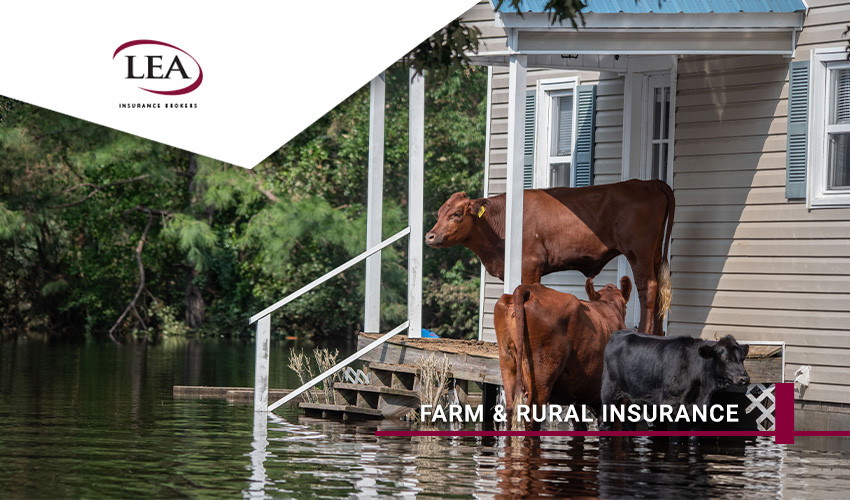
The Impact of Changing Weather on Agriculture
The volatility in commodity prices and a highly variable climate means risks abound for Australian farmers.
According to the Australian Bureau of Agricultural and Resource Economics and Sciences (ABARES), these factors and others mean Australian farmers experience more variation in farm output than most other countries. This variation is also higher than business owners in other Australian economy sectors.
Australian farmers face significant climate risk
One of the most significant risks to Australian farmers – the climate and what farmers can do to mitigate it — is under the spotlight with this article. Since 1970, there’s been 20% less winter season rain in southwestern Australia and a 12% decrease in south-eastern Australia. Since 1910, Australia’s climate is 1.4oC on average, particularly since 1950.
The waves of drought, floods, bushfires and La Niña weather patterns might seem like there’s no pattern to our climate. However, ABARES has drawn on 30 years of data to create its farmpredict model, which identifies the effects of price and climate variability on broadacre farms. Check out ABARES’ Drought Risk by Farm Profit tool.
The impact on farm profitability
Due to changes in the climate, average farm profits have slipped by 23% — or $29,200 – per farm in the two decades to 2020. Research shows the risk of meagre farm returns has increased to more than one in five, thanks to climate variability.
There’s a huge difference between a ‘typical’ and a ‘dry’ year. The average cropping farm, for instance, sees profit dive from $230,000 in a typical year to a loss of $125,000 in a dry one. The typical beef farm profit is $5,000 in a dry year, compared with $60,000 for a typical year.
How farmers are mitigating risk
Here’s how farmers are tackling the risks that climate variability deliver:
- Cropping farmers adjust their farm inputs and cropping area size depending on drought conditions and output prices
- Livestock farms hold grain and hack stocks, and reduce herd numbers to prepare for drought
- Farmers diversify in crop and livestock ventures or geographical location to spread their risks
- Cropping farms increasingly invest in improved conservation tillage practices that boost soil moisture,
- Farmers supplement their revenue with off-farm income and maintain a low level of debt on their farms.
Direct-to-consumer selling, such as through farm gate sales and community-supported agriculture schemes, are other alternatives. As well, the CSIRO is working with an ag-tech start-up Agronomeye and Microsoft to build digital twins – a dynamic virtual replica of a physical ecosystem – to help farmers boost yields and optimise sustainability.
Other farmers, such as the Corrigans who run Rennylea Angus in NSW’s Murray Valley, have been planting 100,000 trees to help increase the resiliency of their farming systems. Meanwhile, diversifying has also been popular. Meanwhile, Olympia Yarger, a Canberra farmer produces an alternative livestock feed – maggots. She sells to aquaculture farmers for fish feed, pet companies and pork producers for pork feed.
Possible future changes
Structural changes as a spinoff of climate change could include:
- Shifts in land use
- The average farm size increasing to improve economies of scale
- New diverse income streams such as carbon farming
Amongst these moves is a social enterprise, Cultivate Farms, seeking to match the next generation of farmers with retiring farmers and investors to combine resources to own and run a farm.
Sourcing authoritative climate information is key for farmers to better prepare for the challenges ahead. Useful resources and projects include the Future Drought Fund, Climate Services for Agriculture, Drought Resilience Self-Assessment Tool and Australian Climate Service. Watch out for Agriculture 4.0 – the next generation of technologies to revamp the sector.
Have the right insurance
There’s a range of mitigation strategies on the table for farmers to consider as well as discussing risk management with us. We can customise a package of farm insurance that spans personal and business cover, including:
- Home and contents
- Farm motor
- Farm machinery
- Farm liability insurance
- Livestock, fencing, and crop insurance
- Farm loss of income and business interruption insurance.
Keep in touch with us about new options for insurance. For example, crop farmers might consider index insurance, which offers a pre-agreed payout without the need for on-farm assessment. It’s a more flexible insurance policy that costs up to 40% less than multi-peril crop insurance.
